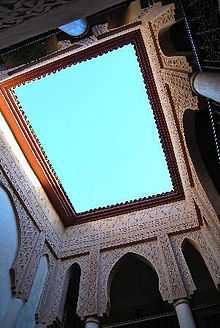Moroccan riad

A riad (Arabic: رياض) is a traditional Moroccan house or palace with an interior garden or courtyard. The word riad comes from the Arabian term for garden, "ryad".[1] The ancient Roman city of Volubilis provides a reference for the beginnings of riad architecture during the rule of the Idrisid Dynasty.[2] An important design concern was Islamic notions of privacy for women inside residential gardens.
When the Almoravids conquered Spain in the 11th century they sent Muslim, Christian and Jewish artisans from Spain to Morocco to work on monuments.[3]
The riads were inward focused, which allowed for family privacy and protection from the weather in Morocco. This inward focus was expressed in the central location of most of the interior gardens and courtyards and the lack of large windows on the exterior clay or mud brick walls. This design principle found support in Islamic notions of privacy, and hijab for women. Entrance to these houses is a major transitional experience and encourages reflection because all of the rooms open into the central atrium space. In the central garden of traditional riads there are often four orange or lemon trees and possibly a fountain. The walls of the riads are adorned with tadelakt plaster and zellige tiles, usually with Arabic calligraphy, with quotes from the Quran.
The style of these riads has changed over the years, but the basic form is still used in designs today. Recently there has been a surge in interest in this form of house after a new vogue of renovation in towns such as Marrakech and Essaouira where many of these often-crumbling buildings have been restored to their former glory. Many riads are now used as hotels or restaurants. Pictured below are two examples in Marrakech, one renovated and serving as the Hotel Riad Laksiba and the other as yet unrenovated.

See also
Notes and references
- ↑ Blaser, Werner. (2004). Courtyards in Marrakech. Basel, Switzerland: Publishers for Architecture.
- ↑ Boele, Vincent. Ed. (2005). Morocco: 5000 years of Culture. Amsterdam: KIT Publishers.
- ↑ Parker, R. (1981). A Practical Guide to Islamic Monuments in Morocco. Charlottesville, Virginia: Baraka Press. pg.14